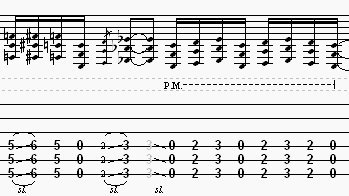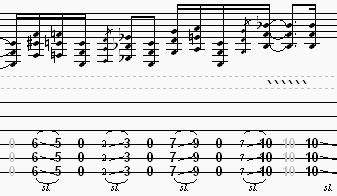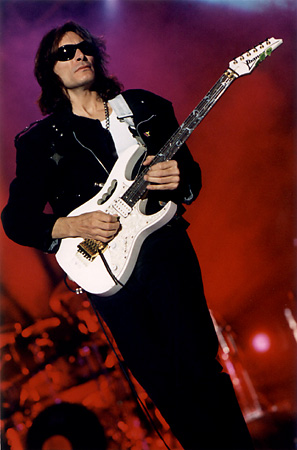Composer – Steve Vai
Where to find this song – Alien Love Secrets track #1
Release Date – June 1997
Steve Vai is a pyrotechnic guitar genius. For a song that sounds so harsh, ironically, it is about an old western showdown on horseback. You would think he would have gone back to the roots of most music and played out a few simple but catchy chords and would have been done. NO WAY! Instead, Vai searched in the deepest regions of his soul to find what we now know as – one BAD HORSIE!!!!!!!!
This song is played using a slide for parts of it. The song itself isn’t too hard, but there are tricky fingerings to make it sound as close to the real thing, so pay close attention.
Main Riff

How To Play It
Drop D Tuning
This song is in drop-D tuning. In drop D tuning the low E string is tuned down one whole step to D.
Part 1

First, look closely at the tablature. Notice around halfway through the first measure there is a “P.M.” Remember that stands for “palm mute.” To do a palm mute, allow the lower part of your pick hand to rest on all strings not being played. Notice at the end of the second measure there is also a “trill.” A trill is when you hammer on and pull off consecutively as fast as possible. Ok, now that all the mumbo jumbo is talked about-ON TO THE SONG!
The first measure starts you off playing a slide WITH a slide. If you cannot find an actual slide around your house, you may find a glass bottle about the size of a beer bottle or an old-style coke bottle (glass of course). You can also pick one up at your local music store relatively inexpensive ($5-20).
Begin by placing the slide on your 2nd finger. Place it on the fifth frets of the “low E” string, the “A” string, and the “D” string. What you will want to do is slide it to the sixth fret on all of the same strings. You will hear a distinct difference and the benefit of a slide as long as you don’t push down too hard on it. It will sound much like an old bluegrass/folk country song. Now, practice with trying to hear that distinctive sound by pushing lighter or harder on the strings. You will know when it sounds right. Ok, now, after you have gone back and forth with that trying to make it actually “slide” well, you will need to use your 1st finger to play the fifth fret on the “low E” string, the “A” string, and the “D” string. Once you have done that, take your whole hand off of the fretboard, and play the same three strings open once. Then you will want to go back to using your 2nd finger and play the second fret of the same strings we have used the whole time, and slide to the third fret of the same strings. Immediately after you do that you will want to barely accent that third fret one more time and then when going up the neck, lift off of your fingers and strike the strings once more lightly to the open position. Now, all of that should have been performed with your 2nd finger. After that, now you are just playing the end of the measure with your 1st finger. Play the same strings as you have from the beginning, and go from the second to the third fret, lift off your finger and play that once, then go back to the second fret. Then you will go to the third fret of the same strings, back to the second fret, and then open one last time to finish this measure. Seems much easier than it looks huh?
Part 2

For the second measure, you will basically be playing the same kind of arrangement, with just different frets. Start by playing the last note of the first measure in the beginning of the second measure (open notes on the same strings you used from the beginning). Now instead of going from the fifth fret to the sixth fret, you just need to do the exact opposite and play it the same way. After you have done the slide WITH a slide, play those same strings open once. Notice what is next. It is the same thing you did from the first measure that was a slide WITH a slide. You then play the next notes open. Here is where you will notice that the song is changing a bit on you. You will need to perform this slide doing the same thing that you did when you started the riff, except this time you go from the seventh fret to the ninth fret on the same strings. After that you let off of the strings and play the notes open once. Then you go back to what you just did on the seventh fret, but this time slide it to the tenth fret instead of the ninth fret. Once you have done the slide with your 2nd finger, quickly replace that same finger with your 1st finger to perform the trill while you are playing on the second time, because it won’t sound right with the slide in its place. The trill is all on the tenth fret of the same strings, so when you play the tenth fret, play it as fast as you can ( of course in time with the song), and then slide down the neck. You are finished! Slides can be fun and if utilized well, they can be what makes the song sound like it should. Just think of “Loser” by Beck. He used a slide for that song.
Bonus
Here’s a galloping riff from the song. It’s fairly primitive in approach but creates a great “horse trot” effect.

